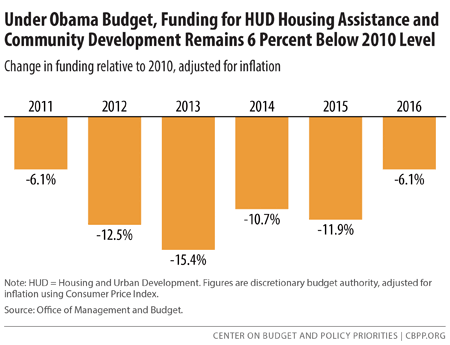BEYOND THE NUMBERS
My latest post for the National Housing Institute’s Rooflines blog lists three key facts about the President’s 2016 budget request for the Department of Housing and Urban Development (HUD). The full post has the details, but here are the main points:
- The proposed funding increase is much more modest than it may appear. Some $2.3 billion of the $6.2 billion increase reflects the expected decline in income from HUD’s mortgage insurance programs, which help fund other HUD programs. And even with the increase, total funding for HUD’s core housing assistance and community development programs would remain 6.1 percent below the 2010 level, adjusted for inflation (see graph).
Image

-
The lion’s share of added resources would go to sustaining rental assistance for the 4.6 million low-income families that now receive it, fully restoring Housing Choice Vouchers lost due to the sequestration budget cuts, and doing more to reduce homelessness.
After sequestration forced state and local housing agencies to reduce by some 100,000 the number of families using Housing Choice Vouchers, Congress provided sufficient funds in 2014 and 2015 to enable agencies to restore roughly a third of those vouchers. The President’s funding request for voucher renewals should be sufficient to continue all vouchers in use this year. The budget also includes funding to restore an additional 67,000 vouchers, which —together with the requested renewal funding — would fully reverse the sequestration-related cuts in 2016.
Building on a strategy that has sharply reduced homelessness among veterans, the budget targets 30,000 of the restored vouchers to families, veterans, and tribal families who are homeless, victims of domestic and dating violence, and families with children who are engaged with child welfare agencies.
And, the President requests an increase for McKinney homeless assistance grants, most of which would support the creation of 25,500 new units of permanent supportive housing for chronically homeless people.
Overall, the budget proposals would support rental assistance for an additional 100,000 families in 2016, with most of the assistance targeted to address homelessness.
-
The President’s budget
isn’t necessarily “dead on arrival” in the Republican Congress. The President’s budget assumes that Congress will eliminate the sequestration-level spending caps enacted under the 2011 Budget Control Act for the 2016 budget cycle, freeing up $37 billion in additional spending for non-defense discretionary programs (including those at HUD). Clearly, the House and Senate will reject this plan in drafting a budget resolution this spring.
But while Republicans may initially reject the President’s overall spending proposal, the House and Senate Appropriations Committees will certainly consider the individual spending requests spelled out in his budget. In addition, the President and Congress will likely engage in budget negotiations at some point this year, in which case the President is expected to argue forcefully for raising the sequestration-level spending cap in 2016.
